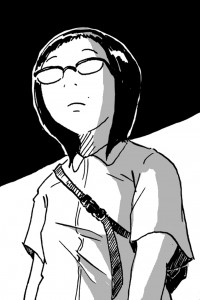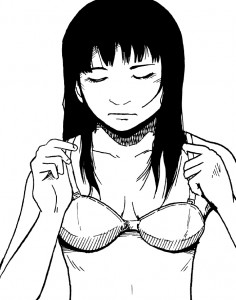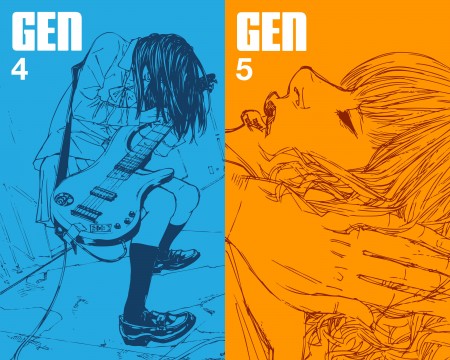Gen Manga Issues 4 & 5 Review
The fourth and fifth issue of Gen Manga continue to evolve and mature, further developing ongoing stories while more obviously stepping closer to becoming the cutting edge alternative manga showcase that the magazine promises to be.
Shige Nakamura’s “Wolf” continues to unfold as a good old-fashioned sports drama. But a variety of development emerges in the fourth installment. Nakamura’s graphic art is gradually evolving. Chapter four, especially, exhibits a decreased focus on background and more refinement in its character art, making the manga less of a throwback and more of a uniquely stylized contemporary manga influenced by 60’s and 70’s manga aesthetics. Chapter four introduces a new element of humor that does a great job of counterbalancing the dour tone of the drama. And the fourth chapter continues to peel back the psychology of protagonist Naoto’s estranged parents. Whether by accident or in respect for the readers’ intelligence, the fourth chapter alternates the use of “wolf” with “okami” without any translator note explanation. Both installments include some mildly salty language, but the occasionally strong dialogue enhances the narrative, giving it a sense of reality. The fifth chapter allows a typo in the dialogue to slip by: “bait” spelled “bate.” The dialogue translation in the fifth chapter also frequently feels a bit stilted. But the fifth chapter also introduces a prolonged boxing match that keeps the pace and tension of the story high.
The pacing of Yu Suzuki’s romantic melodrama “VS Aliens” picks up considerably in issue four before declining into a stew of absurd, rapid fire plot twists that feel as much like desparation as carefully plotted narrative. As this particular series has done repeatedly, the graphic art quality improves in the fourth chapter then receeds again in the fifth.
Mihara Gunya’s “Kamen” series likewise gains momentum in its fourth and fifth installments. While the art looks just a bit stiff in the early pages of issue four, the action picks up considerably throughout issues four and five. These two installments also begin to suggest some context for the story that may answer some reader questions.
Arisa Karino’s graphic art largely continues to impress in Souls. Fine detail, texture, and ample use of screentone give the visual art a sumptuous depth and tone. Unfortunately, Karino still seems challenged by natural, human looking facial proportions, and dialogue remains periodically difficult to attribute to a speaker, or even difficult to decipher, as though characters speak at each other instead of with each other. Unfortunately, typos and poorly translated lines like, “The saw beyond your the five senses,” and, “Then that’ll the end for us,” make following the dialogue even more difficult. While this new story arc presented in issues four and five seems a bit better developed than the first story arc, situations like a lengthy abstract philosophical debate between two prostitutes regarding their psychological acceptance of their roles and status, using a wounded pigeon as a metaphor, seems near laughably unbelievable.

Issue four concludes on a high note with Takayuki Fujimura’s self-contained short story “Sorako.” This nice story about young adult ennui and the way that small, routine events shape people’s perspective and personality is illustrated with a compact, stylized art that may be called contemporary gekiga. The concise art and storytelling do a fine job of focusing succinctly on expressing action through art & dialogue. This is far from shounen action/adventure, but it’s also not anime-esque iyashikei slice-of-life. This looks and feels like personal transformation presented through graphic storytelling. Not for readers that want tales of ninjas or aliens or even high school romance, this is a pleasant story for readers that appreciate manga as literal visual storytelling.

Taguchi Hajime’s “Alive” that ends Gen Manga issue five aims for a similar effect but succeeds just a little less successfully. This Kafka-esque gekiga drama about hopeless, despair-riddled people who rediscover self-respect and purpose in their lives is intriguing, but the pivotal epihanies that the characters have could be better illustrated, to make the turning point in these characters’ lives more evident to readers. Although not exploitative or sensationalistic, “Alive” does depict some provocative and adult subjects and images that elevate the story into respectable adult literature but may also surprise readers used to the typically all-ages friendly content that Gen Manga has published thus far.
Gen Manga was founded on a principle of being brand new, cutting-edge independent Japanese manga to English speaking readers. The publication’s first three issues have done a commendable job of introducing new Japanese talent and beinging new manga to American readers, but it’s issues four and five that first begin to fulfill the promise of publishing not just new indie manga but new cutting edge manga that aims for an older, more sophisticated audience. Issues four and five don’t eschew the popular genres of action, supernatural, romantic comedy, and fantasy manga; these two issues compliment conventional themes and genres with more provocative, literary, adult-oriented manga tales.
Add a Comment
You must be logged in to post a comment.






It seems the fourth part has been inserted many new things.